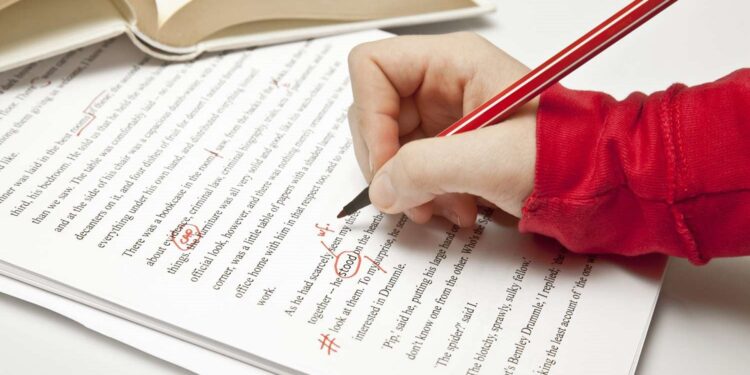Having a brochure or newsletter published that is full of typos, misspelled words, and grammatical errors is one of the worst things that can happen to a business. The services of a writer or editor who can consistently deliver work free of mistakes are invaluable. Offering proofreading or editing services is a great way to expand your writing-related freelance business.
However, mastering the art of proofreading does not require anything more than a red pen. Learning to spot mistakes in written work requires time and effort. The time spent perfecting your proofreading skills will be worth it once you reap the benefits. Clients will come calling for more work if you have proofreading experience.
How Does One Go About Book Proofreading?
The book proofreading company knows editing is complete when you start working with a proofreader. A proofreader will verify your manuscript again before sending it to print (or electronic publication). They will ensure that your book has no typos, grammatical errors, or anything else that could detract from the reading experience.
A skilled proofreader will not only catch typos and grammar mistakes like missing commas and incorrectly used homophones but will also do so with an unerring eye for detail. They will also ensure no typos or formatting concerns in your proof, such as the inappropriate typeface for a chapter heading or lines that are too closely or too widely spaced.
A good book proofreading company should have the eyes of a careful reader and the brains of a critical editor, catching every error and leaving nothing out. Where, though, can you track down a proofreader who will go through your book line by line and ensure everything is correct?
Is A Line Editor The Same As A Proofreader?
A “line editor” performs much the same function as a proofreader in the United Kingdom difference. The sole distinction is that a proofread is done on the final, printed version of the work, whereas a line edit is done on the manuscript version. It is not common practice for a British author to have a line editor and a proofreader check through their manuscript.
However, in the United States and Canada, the term “line editing” generally refers to a combination of content editing and developmental editing, where the focus is mainly on the work’s artistic substance and style. On other occasions, it refers to a more in-depth form of copy editing.
If a resume mentions “line editing,” you should ask the editor what they mean. All editors are clearly labeled as developmental editors, copy editors, or proofreaders, eliminating any ambiguity regarding their services.
To hire the best book proofreading company, think about the following tips:
Know Exactly What Your Tasks Include
This is known as “the brief” in the business world, where you get your assignment. For instance, when editing a text, do you prefer to be the first person to do so or the last person in a long line of writers/editors whose duty is to check for spelling and grammar?
How much time you have to make changes or additions is also limited by the deadline for the final product. A careful proofreading of the already written material is preferable to a hasty or careless edit, even if time is of the essence. Remember that you increase the likelihood of making a mistake every time you modify. Feel free to ask questions if you need clarification.
Keeping the book proofreading company author’s voice intact is crucial. After working together, you’ll learn your Executive’s favorite expressions and idioms. If you need to learn their writing style, look at older papers to understand it. If your organization has a “house style” for formatting or grammar, you should use it, even if it goes against your personal preferences.
Put:
- Fix it if it’s wrong.
- If it meets your standards, don’t change a thing.
- If it isn’t bad and you don’t like it, don’t change it.
Use Multiple “Passes” To Thoroughly Proofread The Document
If this is a document you have never seen before, giving it two (or more) reads can help you get acquainted with the material and reduce the likelihood that you will miss any glaring mistakes.
The initial go-through could be for layout, ensuring things like sequential page numbers, consistent justification, headers that are relevant to the text, and uniform heading styles across a lengthy letter or report. The second reading could focus on the content, checking for typos and poor usage.
Methods for Correcting a Document’s Numerous Typos
- Read at a leisurely pace.
- Make sure to make common mistakes with apostrophe usage.
- Look for transposed letters (form/from or sued/used) or a single incorrect letter in a short word (or/of, now/not, if/it) instead of relying on the Spellchecker.
- Words like “discreet,” “discrete,” “principal,” and “principle” are often confused, so be careful.
- The use of unnecessary words, especially filler words like “is,” “in,” and “it,” should be checked.
- Consider who you’re writing for; should you use American or English spelling? Maintain coherence.
Finally, remember to reevaluate your posture and take frequent breaks.
Practice good proofreading techniques. Careless proofreading is a sure way to let errors sneak through. Make a plan to hire the best book proofreading company to simplify the process of finding and fixing mistakes.
Reading the material backward can be helpful for specific proofreaders. Some people will read it aloud to hear how it flows. Improve your ability to concentrate while proofreading so you can make all crucial corrections.
Don’t Rush Anything
It’s always a good idea to proofread something at the last minute. The best proofreaders will read a document more than once before sending it off to be printed.
Allow yourself plenty of time to find and correct any mistakes you make. The best way to proofread is to start with the spelling, go on to the grammar, and then finish with the punctuation.
Final Thoughts
No matter what sort of work you do, vital proofreading and editing skills will serve you well. The company’s website, brochures, leaflets, and other printed materials could all benefit from your expertise.
Writing (and, by extension, editing and proofreading) has remained constant in the dynamic workplace, and the proliferation of blogs, websites, mobile apps, and electronic books has increased the amount of written content we absorb.












